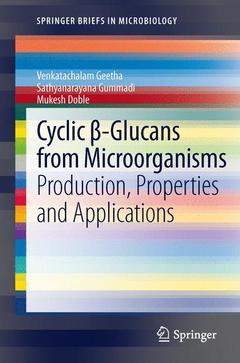Description
Cyclic β-Glucans from Microorganisms, 2013
Production, Properties and Applications
SpringerBriefs in Microbiology Series
Authors: Venkatachalam Geetha, Gummadi Sathyanarayana, Doble Mukesh
Language: English
Subjects for Cyclic β-Glucans from Microorganisms:
Approximative price 52.74 €
In Print (Delivery period: 15 days).
Add to cart90 p. · 15.5x23.5 cm
Description
/li>Contents
/li>Comment
/li>
to Cyclic glucans are polysaccharides that are predominantly produced by Agrobacterium, Bradyrhizobium and Rhizobium sp. and widely used in the pharmaceutical and food industries. In this book, the applications, properties, analytical tools, production and genes of four main cyclic ?-glucans from microorganisms are highlighted and critically evaluated. As biocompatible and biodegradable renewable resources, they have an immense potential for future applications, which has not yet been fully exploited. This concise review will help to bridge this gap.
1. Introduction
1.1. History of polysaccharides from bacteria
1.2. Cyclic β-glucans
1.3. α-cyclic glucan
1.4. Linear glucans
1.5. Cyclodextrins
2. Applications of cyclic β-glucans
2.1. In food
2.2. Medical technology
2.3. As wound dressing material
2.4. Microparticulate form of β-glucan for pharmaceutical application
2.5. Synthesis of selenium nanowires
2.6. Drug delivery
2.7. Enantiomeric seperator
2.8. In chiral technology
2.9. Chiral Stationary Phase
2.10. Carboxymethylated cyclic- β-glucans as enantiomeric separators
2.11. Inclusion complexes
2.12. β-D-Glucans complexation with Zearalenone
2.13. Inclusion complex with Paclitaxel
2.14. Inclusion complexation with a plant flavonoid luteolin
2.15. Inclusion complexation with naproxen
2.16. Functionalized β-1, 3-Glucan in carbon nanotube
2.17. Application of cyclic β-(1, 3),(1, 6)-glucans in chiral technology
3. Properties of cyclic glucans
3.1. Structure
3.2. Molecular biological function of β-Glucans in immunity
3.2.1 The β-Glucan receptor - Dectin-1
3.3. Complex forming ability
3.4. Cytotoxicity of cyclic β-glucan
4. Analytical tools for the characterization cyclic β-glucan
4.1. Silica gel thin-layer chromatography (TLC)
4.2. Degree of polymerization
4.3. Compositional analysis of periplasmic glucan
4.4. Glycosidic - linkage analysis
4.5. Arrangement of linkages
4.6. Protons and carbons in glucan
4.7. Molecular weight
4.8. Functional groups in cyclic β-glucans
4.9. Supramolecular structure
4.10. Separation of mixture of cyclic-β- glucan in HPLC
4.11. CHN analysis
5. Production of Cyclic β-glucans
5.1. Osmolarity condition
5.2. Media details
5.3. Optimization of medium with mannitol
5.4. Effect of media components and operating conditions
5.4.1. Carbon
5.4.2. Nitrogen
5.4.3. Temperature
5.4.4. Salt and pH
6. Extraction and purification of cyclic β- glucan
6.1. Extraction of cyclic β- glucan from culture filtrate
6.2. Isolation and purification of osmoregulated periplasmic glucans
6.3. Isolation and purification of algal cyclic glucans
6.4. Purification of cyclic glucan from yeast
6.5. Purification using column chromatography
7. Mechanism of cyclic β-glucans production
7.1. Genes responsible for synthesis of cyclic β-(1, 2)-glucan in Rhizobiaceae and Agrobacteriaceae
7. 1.2. Genes for cyclic β-(1,3)
7. 1.3. Genes for cyclic β-(1,3)-(1,6)-glucan
7. 1. 4. Genes for cyclic β-(1,6)-(1,3)-glucan
7. 2. Genes of periplasmic glucans (PGs) of the Proteobacteria
7.3. Metabolic pathway of carbohydrate metabolism
7.4. Enzymes involved in Cyclic β- (1,2)-glucan synthesis
7.4.1. Cyclic β-glucan synthase (Cβgs)
7.4.2. β- (1, 3), β-(1,6)-(1,3) and β-(1,3)-(1,6) glucosyltransferase
7.4.3. Enzymes involved in β-glucan degradation
8. Conclusions
First book that solely discusses the cyclic ß-glucans from microorganisms
Comprehensible overview
Written by experts in the field
Includes supplementary material: sn.pub/extras




